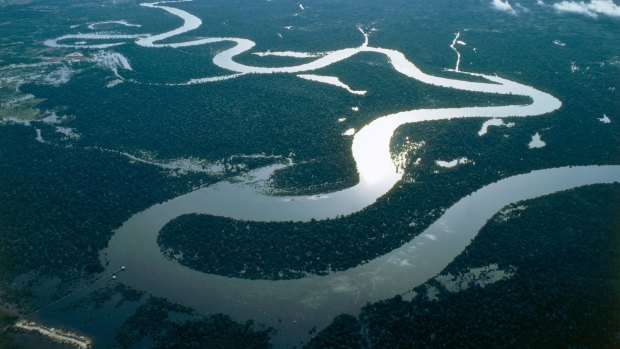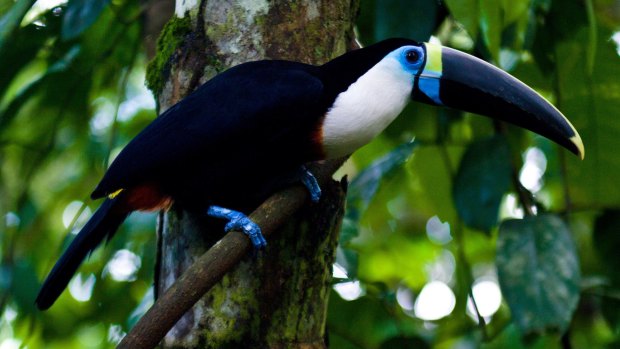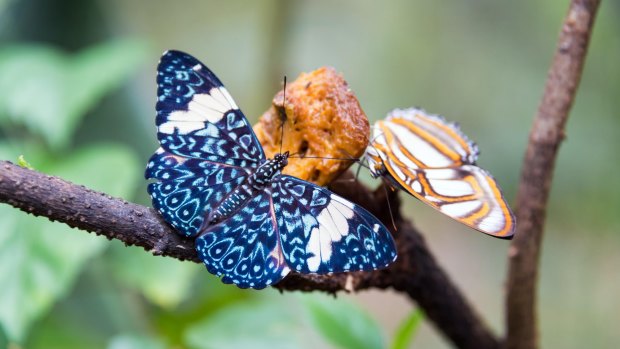This was published 8 years ago
Float through the wilds of Peru's Amazon in luxury
By Christine Manfield
I am in the river town of Iquitos, north-east Peru, the gateway to the Amazon on the eastern ridges of the Andes mountains. This town, the most inland port in the world, some 5000 kilometres from the river's mouth in the Atlantic Ocean, feels dilapidated yet buzzing with life. It's a remote frontier cut off from the world, surrounded entirely by water with the only access by boat or plane.
We drive through the busy streets jammed with tuk-tuks and motor bikes, past faded mansions built by the rubber barons who made their fortunes here in the late 19th century until the industry collapsed around 1912. The story of Fitzcarraldo springs to mind, a movie by Werner Hertzog filmed on location in the early '80s about a rubber baron's obsession with building an opera house in his home town. Sixty per cent of Peru is classified jungle and we are in the heart of it, the greatest remaining wilderness on earth. Its vastness is mind boggling, a silent witness to the immense beauty.
Our group of boat arrivals is transported in a canoe to the middle of the river in the centre of town to a thatched-roofed restaurant Al Frio y Al Fuego for a lunch of catfish ceviche and local seafood. Afterwards we venture into one section of the vast Belen Market for a glimpse of town life at work, past the colourful displays of edible fruits that characterise the river wetlands. There is a cacophony of sounds and all manner of sights and smells; it's not for the faint-hearted, but it certainly is an exotic market with every type of produce imaginable.

Aerial view of the Amazon River near Iquitos - Loreto Region, Peru.Credit: Alamy
We leave Iquitos and drive north for 90 minutes to Nauta, another river outpost at the source of the Amazon where the Mananon and Ucayali rivers meet. Here we board the Aria Amazon, one of two Aqua Expeditions boats in Peru, cruising the upper reaches of the Amazon year round since 2007. It's a floating hotel, a generously proportioned 16-berth riverboat that exemplifies low-key luxury.
The downside of our visit in the dry season is that restricted flight times to Iquitos mean we have a six-hour wait before we can board. Settling into our suite, which has floor-to-ceiling windows, the sense of isolation engulfs us as we glide down the river away from the lights of the town into the heart of darkness.
On board, the itineraries vary according to duration of trip and time of year, broken in two seasons – wet (December to May) and dry (June to November). The bird, animal and marine life changes dramatically between the seasons, so any time of year offers terrific and different sightings. During the wet season, the rivers swell to form an inland sea that becomes the largest flooded forest in the Peruvian Amazon with the cycle of life and bird migrations before the waters start to recede in the dry season.

Blue skin surrounds the eye of a White-throated Toucan with its enormous yellow and blue striped bill perched on a vine in the rainforest. Credit: Alamy
The rivers are the highways of the Amazon forest and we share the waterways with canoes and rafts to large freight boats that bring essential supplies into these remote parts. On each of our morning and afternoon river safaris, our on-board expert naturalist guides (Luis, George, Roland and Ricardo) share their wealth of knowledge as we break into small groups and explore the rivers and black water creeks in the Pacaya Samiria National Reserve in small skiffs that skim the surface as every bend reveals more of this wildlife sanctuary. The impenetrable forest pulses with a diverse wildlife, most of it invisible, and we glimpse small village communities that coexist sustainably with the rainforest and drenching rains without electricity.
We see playful pink dolphins, a sloth, iguanas, tiny bats, butterflies, toucans, falcons, kingfishers, egrets, herons, cormorants, tamarin monkeys and scarlet-bellied piranha whose razor sharp teeth can shred a buffalo carcass in seconds. The only thing we don't see is the elusive anaconda. We spot gigantic Victoria water lilies, up to three metres in diameter that grow in the ponds and lakes behind the riverbanks. Vivid-coloured heliconias hang majestically among the trees and villagers relish the opportunity to sell their handicrafts, mementoes of river life.
An evening safari up one of the creeks has us on the look out for lurking caimans (freshwater crocodile) and our guide drops his hand overboard and pulls up a metre-long specimen, expertly grabbing it behind the neck and swinging it around onto the skiff for us to ogle from a safe distance. An afternoon jungle safari has us walking into the rainforest away from the river with a local villager, sweat pouring with every step under our protective clothing, the air thick with humidity. He forages for plants and insects to reveal the secrets of the rainforest, what plants are used for food and medicine, some tiny brilliantly coloured frogs used in blow pipes, tarantulas, snakes, tiny tree monkeys and iguanas clinging to tree branches. It's an alien world.

Butterflies near Iquitos, Peru, gateway to the Amazon. Credit: Alamy
Our time passes quickly, we fall into the natural rhythm of river life, whether it's from the privacy of our suite with uninterrupted views of the moody skies, to having a massage, a dip in the outdoor jacuzzi or lounging in the bar on the upper deck sipping on a pisco sour or camu camu juice. This is not your typical boat cruise; the emphasis here is on adventuring into the natural environment and exploring its extraordinary beauty, appreciating the fragile ecosystem and stopping to take it all in. A staff of 24 takes care of the guests and, as we plow through the water, we pinch ourselves to be reminded that we are wrapped up in modern luxury in one of the world's wildest and most remote landscapes.
MORE INFORMATION
See www.visitperu.com . To plan your Peru itinerary contact Epicurious Travel (www.epicurioustravel.com.au ).
For details about riverboat itineraries, see www.aquaexpeditions.com .
GETTING THERE
LAN operates flights from Lima to Iquitos twice a day. Times are subject to change. See www.lan.com .
Visas are not required for Peru. You are issued with an Andean pass on arrival that you keep in your passport for the duration of your stay in Peru. This must be shown when checking into hotels – without it, you are charged an extra tax.
STAYING THERE
Aqua Expeditions operates three, four and seven-night Up River and Down River cruises on the Amazon. Cruises start at $4600 per person. Private transfers and single supplements are available. See www.epicurioustravel.com.au , www.aquaexpeditions.com.
SEE AND DO
Make time to walk through the vast Belen Market in Iquitos, with an amazing array of exotic jungle produce that stretches across 20 blocks.
DINING THERE
Al Frio y Al Fuego, Iquitos. Stop off for a ceviche lunch. See www.alfrioyalfeugo.com
Christine Manfield travelled with the assistance of aquaexpeditions.com.
Sign up for the Traveller Deals newsletter
Get exclusive travel deals delivered straight to your inbox. Sign up now.